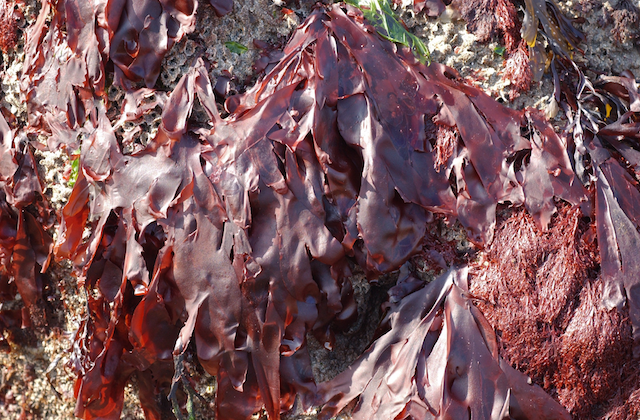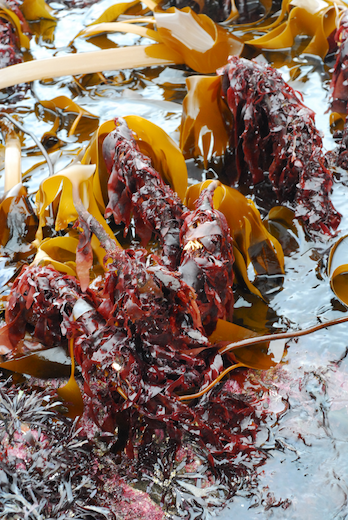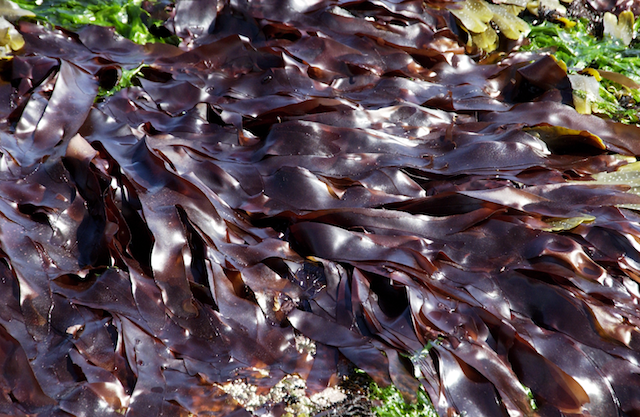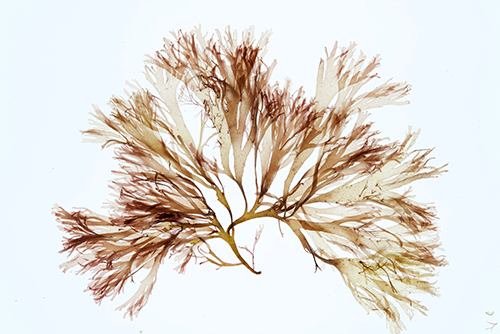Palmaria palmata (Linnaeus) Weber & Mohr

Also known as Rhodymenia palmata
Common names: Dulse, Dillisk (English), Dilleasc, Creathnach (Irish)
Description: Reddish brown, membranous or leathery, flattened fronds, 50-300 (1000) mm long, arising from a discoid base, usually with a small stipe expanding gradually to form simple or dichotomously and palmately divided fronds, often with characteristic marginal leaflets. Blade very variable in shape, having broadly ovate to narrowly linear segments.
 Habitat: On rock, mussels and epiphytic on several algae, intertidal (at all levels but particularly near low water) and shallow subtidal , especially on upper part of Laminaria hyperborea stipes (right. to a depth of about 5 m), widely distributed, abundant. Undivided or sparingly divided forms occur on mussels on exposed shores and sometimes in the subtidal (to 20 m in exceptionally clear water); plants growing on exposed shores, known in Ireland as Creathnach, are considered to be more palatable than the leathery plants of the lower intertidal of semi-exposed shores, which are usually dried and sold as Dillisk or Dilleasc; these forms may ultimately prove to be a separate entity. A very finely dissected form grows epiphytically on rocks, pedbbles and Fucus serrratus in the sheltered parts of semi-exposed shores where silt or fine sand accumulates; this is sometimes known as the “var. sobolifera” or “var. sarniensis” and is much less common than the other forms.
Habitat: On rock, mussels and epiphytic on several algae, intertidal (at all levels but particularly near low water) and shallow subtidal , especially on upper part of Laminaria hyperborea stipes (right. to a depth of about 5 m), widely distributed, abundant. Undivided or sparingly divided forms occur on mussels on exposed shores and sometimes in the subtidal (to 20 m in exceptionally clear water); plants growing on exposed shores, known in Ireland as Creathnach, are considered to be more palatable than the leathery plants of the lower intertidal of semi-exposed shores, which are usually dried and sold as Dillisk or Dilleasc; these forms may ultimately prove to be a separate entity. A very finely dissected form grows epiphytically on rocks, pedbbles and Fucus serrratus in the sheltered parts of semi-exposed shores where silt or fine sand accumulates; this is sometimes known as the “var. sobolifera” or “var. sarniensis” and is much less common than the other forms.
Similar species: The finely-divided forms are sometimes misidentified as Gracilaria multipartita, the latter is, however, very thick and fleshy, and is relatively uncommon.
Key characteristics: The palmate branching with its finger-like extensions is very characterstic; most plants have marginal proliferations at the base. Young plants can be less leathery and may be thin and slippery.
 Usage: This plant was widely used for food, dried and eaten uncooked, by the maritime Irish and Scots and under other names in Iceland, Norway and France. Plants are still sold in the west of Ireland (as Dillisk or Creathnach). The species is not particularly palatable fresh but, if dried carefully and rapidly, is one of the few seaweeds with a pleasant taste and mouth-feel. It is best accompanied by dark ales (beer) or stouts. Cultivation has been succesfully achieved on ropes and in tanks in Ireland and Germany, repectively.
Usage: This plant was widely used for food, dried and eaten uncooked, by the maritime Irish and Scots and under other names in Iceland, Norway and France. Plants are still sold in the west of Ireland (as Dillisk or Creathnach). The species is not particularly palatable fresh but, if dried carefully and rapidly, is one of the few seaweeds with a pleasant taste and mouth-feel. It is best accompanied by dark ales (beer) or stouts. Cultivation has been succesfully achieved on ropes and in tanks in Ireland and Germany, repectively.






